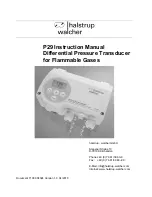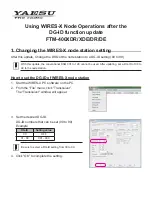
K3138V1 5/06 Rev. A
ZR530
ZR530
ZR530
ZR530
PASSIVE INFRARED MOTION
PASSIVE INFRARED MOTION
PASSIVE INFRARED MOTION
PASSIVE INFRARED MOTION DETECTOR/TRANSMITTER
DETECTOR/TRANSMITTER
DETECTOR/TRANSMITTER
DETECTOR/TRANSMITTER
INSTALLATION INSTRUCTIONS
GENERAL INFORMATION
The ZR530 Passive Infrared Motion
Detector/Transmitter is a battery-operated wireless
device.
Designed for use in commercial and residential
installations, the ZR530 is a wall-mounted unit with
a standard lens that provides wide-angle
protection up to a range of 12m. For best
coverage, mount the detector so that the likely
direction of intruder motion is
across
the pattern.
This document provides installation instructions
for the ZR530, but the installer must be familiar
with the Installation Instructions for the FBII control
panel with which the ZR530 is intended to be
used.
FEATURES
•
Wireless operation for fast installation.
• Dual-element pyro-electric sensor provides
positive protection while minimizing false
alarms.
• Alternate polarity pulse count option offers
greater stability in adverse environments.
• Provision to turn LED on while walk testing
(LED is turned off after testing).
• Tamper-protected cover – unit transmits
message if cover is removed.
• Wall or corner mounting options.
• Optional Pet Alley and Long Range lenses
available.
SYSTEM DESCRIPTION
Optical System
Uses efficiently designed Fresnel lenses.
Radio Transmitter
The built-in transmitter serves only as the
communication link to the alarm system's
Receiver/Control, and can send alarm, tamper,
supervisory, and battery status messages to the
system's receiver/control. The transmitter is not
used for detection purposes. Each detector has a
unique ID code permanently assigned at the
factory. You must program this ID into the control
system at the time of installation. The ID allows
each detector used in the system to be uniquely
identified. You can program the ZR530 as
"supervised " or "unsupervised."
To conserve battery life during normal operation,
no more than one transmission sequence will
occur within a 3-minute period. There is no such
time restriction in "test" mode.
Alternate Polarity Pulse Count
Two jumper-selectable detection response modes
are provided:
Instant response
(Pulse Count OFF)
and
Alternate Polarity Pulse Count
(Pulse Count
ON). With Pulse Count OFF, any detected change
in infrared energy will trigger an immediate alarm
signal. This mode is recommended when the
detector is used to monitor a narrow hallway
where coverage is provided by only a single zone.
Use the Pulse Count ON mode when the detector
is installed in areas where periodic changes in
infrared energy levels are normal (for example,
where forced-air heating ducts are present). In this
mode, at least two changes in infrared energy
must be detected within a short period before an
alarm will be triggered.
Important Note:
If the detector is to be used in
the Pulse Count mode, be sure to walk test the
unit in this mode.
SPECIFICATIONS
Transmission
Frequency:
433.92 MHz
Coverage:
12m
17m
18 zones (9 long, 5 inter-
mediate, 4 short range).
Pulse Count:
Installer-selectable On/Off
link.
Detectable
Walk Rate:
0.15 – 1.5m/sec.
Mtg. Height:
2.1m, but may be mounted
at other nominal heights
(see Table 1).
Walk Test
Indicator:
Red LED with Test/Normal
(disable)
link.
Batteries:
Two
3-volt lithium batteries.
Use only Duracell DL123A,
Panasonic CR123A, or
Sanyo
CR123A.
0perating
Temperature:
0°C – 50°C
Operating
Humidity:
Up to 95% RH (max.), non-
condensing.
Dimensions:
68mm x 127mm x 48mm.
Figure 1.
Standard Wide -Angle Protection Pattern
BATTERY INSTALLATION
1. Remove front cover by inserting a large
screwdriver blade (or small coin) in groove
between cover and base at the location shown
in Figure 2; rotate blade to override snap fit,
then lift cover off.
2.
Observing correct polarity,
install the two
lithium batteries (supplied
)
into the battery
holders,
as shown in Figure 4. Make sure the
batteries are firmly seated.
3. Replace the cover (snap fit).
Battery Caution:
Risk of fire, explosion, and burns. Do not
recharge, disassemble, heat above 100°C, or
incinerate. Dispose of used batteries promptly.
Keep away from children.
Programming Note:
If you have not yet
programmed the detector’s ID into the system
(i.e., this is an initial detector installation), refer
to the
PROGRAMMING
section below and
perform the ID “programming” procedure
before mounting or testing the detector.
PROGRAMMING
You must enroll the detector’s ID during
installation of the system.
Program the control to
enroll the ZR530 as "supervised."
INSTALLATION HINTS
•
Do not install where the detector is exposed to
direct sunlight or directly above strong sources
of heat.
•
Make sure the detection area does not have
obstructions (curtains, screens, large pieces of
furniture, plants, etc.) which may block the
pattern of coverage.
•
Avoid locating a unit in areas which contain
objects likely to produce a rapid change in
temperature, such as central heating, radiators,
or ducts (or heaters of any kind), air
conditioners, open flame, etc.
•
Do not mount on an unstable surface.
INSTALLATION
Radio Transmission Path Check
Verify that a strong transmission path between the
ZR530 and the QED's system Receiver/Control
exists
before permanently mounting the
detector.
Do this by performing the
Walk Test
(described later) with the detector temporarily
mounted in its proposed location. The ZR530 will
transmit when sensing motion (waving an arm or
walking into an area). Sometimes, moving the
detector only a few centimeters means the
difference between a strong and weak
transmission path. Experiment until you are
satisfied that the location provides the strongest
transmission path, while still being practical for the
protection pattern desired. This test also verifies
that the detector has been correctly programmed
into the system.
Normal Mounting
Mount the unit to a firm vertical surface (flat on a
wall or in corner).
1. Remove the front cover.
2. Temporarily loosen (do not remove) the screw
holding the PC board in the detector base (see
Figure 5 for location of this screw).
The board can then be moved up or down for
access to the knockout mounting holes in the
base.
3. Refer to Figure 3 for location of knockout
holes in the base. Break out only those holes
required.
4. Mount the detector with screws, using the
selected mounting holes.
5. Before fully tightening the PC board holding
the screw, make sure the board is positioned
so that the arrow is in line with the appropriate
setting on the graduated scale on the right-






















